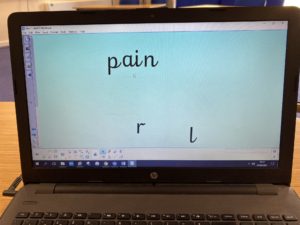

Between lockdowns, pupils being home, and bubbles bursting, Nadine Finlay found her pupils were sometimes missing key parts of their phonic learning.
When pupils were home, she set up short, consistent, and true-to-routine check-ins with pupils to ensure they were not missing out.


We all know that Phonics is the key to reading and by extension writing but over the past year with two school closures and countless bubbles bursting, as the Phonics lead, I became acutely aware that children from FS1 to Year 3 are missing large chunks of their Phonic experiences. Having spoken to many friends and colleagues about Phonics we identified a focus on the lowest 20%, ensuring that they not only had access to the whole class phonic lessons but also 1:1 support to plug the gaps in their knowledge.
By setting up a daily 1:1 online meeting with the child, it is possible to follow a similar structure for interventions as would normally be carried out in school. I feel passionately that the structure, as much as possible, of online interventions, should follow the same format as they normally would if everyone were in the classroom. The children have enough to deal with at present without their known routine changing as well and by having consistency with this structure, they can focus their attention on the new phoneme rather than anticipating any changes.
To begin with, there needs to be an assessment carried out on their Phonic knowledge, identifying any early gaps. If there hasn’t been time for this to happen, either due to absence or perhaps a bubble bursting this can easily be carried out during an online meeting, using flashcards. Then for each following meeting, the structure would remain the same while revisiting and plugging the gaps in their phonic knowledge.
Recap
As with lessons in school, this is time spent recapping prior knowledge with no more than 5 graphemes. It is done using flashcards, held up to the screen, modelled by the class teacher, and then repeated by the child. I find flashcards better at this stage than sharing a screen as I can see the whole of the child’s face as they form the letter shape with their mouth. This way I can support them before any misconceptions are formed and cemented.
Health warning: As with all Phonic training, beware of listening for the pure sound and no added schwa which can so easily reappear if not regularly reinforced.
Introduction
The new grapheme is introduced in a similar way. The class teacher holds up the card and says the phoneme, then pushes it towards the screen and the child repeats it. After repeating this a few times I like to turn it into a game, inserting the new grapheme into the set of other flashcards and when the new card is reached the child will either wave, salute or stand up. I find that by adding an element of enjoyment to what can otherwise be quite a dry task keeps the children keen to find and identify the new sound correctly.
Screen sharing
This is where I noticed that every teacher makes the same mishap.
“Can you see that?”
We all say this but we really shouldn’t because the children don’t know what “that” is. Instead, describe the page being shared.
“Can you see the blue page with a grid of graphemes on?”
This makes it so much clearer for the child you are working with to know exactly what you are talking about and they’re used to the Tier 3 language of graphemes, phonemes and digraphs because it’s used every day in a Phonic lesson.
Significant computing skills aren’t a requirement here, everyone can do this!
By hovering the curser below the different graphemes on the screen the child at the other end of the line will know which ones need to be read and vocalised. Then change the screen to apply the knowledge by building words, with the class teacher moving the graphemes around the screen and underlining them with the curser while the child reads the word once that’s been built before their eyes.
The whole intervention lasts no longer than 5 minutes but is carried out every day, 5 days a week. I found that as the parents were nearby they would reinforce the phoneme that we’d been working on each day and I would also ask the child as I said goodbye to go and teach today’s phoneme to their family. This reinforcement has proved to be invaluable as the children were able to be the teacher, sharing their own knowledge of how to read, pronounce and write the grapheme. The family was able to listen to the lesson, hear how I was saying the sound and then copy it themselves. This is particularly useful for those who have English as a second language (EAL). All in all these short sessions proved to be a huge success for all involved and I hope that by outlining them to you, they’ll be able to help the children in your classes too.